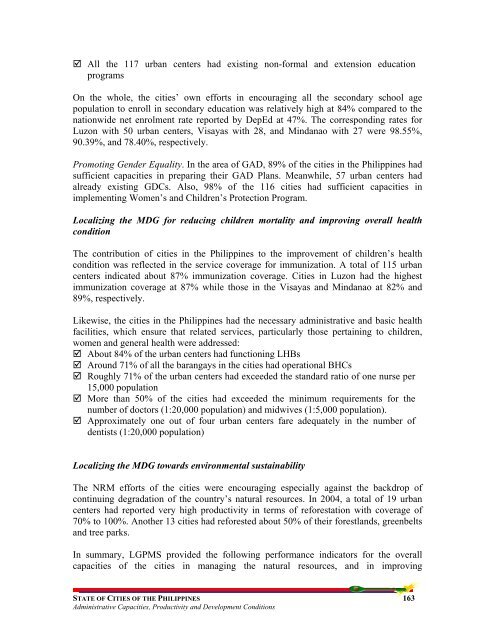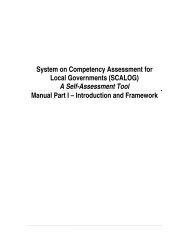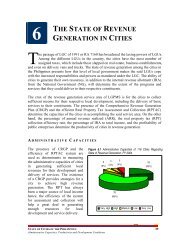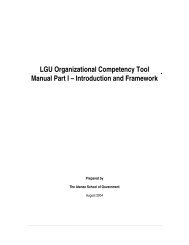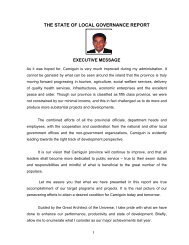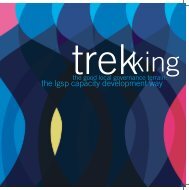19 strategic link to the millennium development goals - LGRC DILG 10
19 strategic link to the millennium development goals - LGRC DILG 10
19 strategic link to the millennium development goals - LGRC DILG 10
Create successful ePaper yourself
Turn your PDF publications into a flip-book with our unique Google optimized e-Paper software.
All <strong>the</strong> 117 urban centers had existing non-formal and extension educationprogramsOn <strong>the</strong> whole, <strong>the</strong> cities’ own efforts in encouraging all <strong>the</strong> secondary school agepopulation <strong>to</strong> enroll in secondary education was relatively high at 84% compared <strong>to</strong> <strong>the</strong>nationwide net enrolment rate reported by DepEd at 47%. The corresponding rates forLuzon with 50 urban centers, Visayas with 28, and Mindanao with 27 were 98.55%,90.39%, and 78.40%, respectively.Promoting Gender Equality. In <strong>the</strong> area of GAD, 89% of <strong>the</strong> cities in <strong>the</strong> Philippines hadsufficient capacities in preparing <strong>the</strong>ir GAD Plans. Meanwhile, 57 urban centers hadalready existing GDCs. Also, 98% of <strong>the</strong> 116 cities had sufficient capacities inimplementing Women’s and Children’s Protection Program.Localizing <strong>the</strong> MDG for reducing children mortality and improving overall healthconditionThe contribution of cities in <strong>the</strong> Philippines <strong>to</strong> <strong>the</strong> improvement of children’s healthcondition was reflected in <strong>the</strong> service coverage for immunization. A <strong>to</strong>tal of 115 urbancenters indicated about 87% immunization coverage. Cities in Luzon had <strong>the</strong> highestimmunization coverage at 87% while those in <strong>the</strong> Visayas and Mindanao at 82% and89%, respectively.Likewise, <strong>the</strong> cities in <strong>the</strong> Philippines had <strong>the</strong> necessary administrative and basic healthfacilities, which ensure that related services, particularly those pertaining <strong>to</strong> children,women and general health were addressed: About 84% of <strong>the</strong> urban centers had functioning LHBs Around 71% of all <strong>the</strong> barangays in <strong>the</strong> cities had operational BHCs Roughly 71% of <strong>the</strong> urban centers had exceeded <strong>the</strong> standard ratio of one nurse per15,000 population More than 50% of <strong>the</strong> cities had exceeded <strong>the</strong> minimum requirements for <strong>the</strong>number of doc<strong>to</strong>rs (1:20,000 population) and midwives (1:5,000 population). Approximately one out of four urban centers fare adequately in <strong>the</strong> number ofdentists (1:20,000 population)Localizing <strong>the</strong> MDG <strong>to</strong>wards environmental sustainabilityThe NRM efforts of <strong>the</strong> cities were encouraging especially against <strong>the</strong> backdrop ofcontinuing degradation of <strong>the</strong> country’s natural resources. In 2004, a <strong>to</strong>tal of <strong>19</strong> urbancenters had reported very high productivity in terms of reforestation with coverage of70% <strong>to</strong> <strong>10</strong>0%. Ano<strong>the</strong>r 13 cities had reforested about 50% of <strong>the</strong>ir forestlands, greenbeltsand tree parks.In summary, LGPMS provided <strong>the</strong> following performance indica<strong>to</strong>rs for <strong>the</strong> overallcapacities of <strong>the</strong> cities in managing <strong>the</strong> natural resources, and in improvingSTATE OF CITIES OF THE PHILIPPINES 163Administrative Capacities, Productivity and Development Conditions


